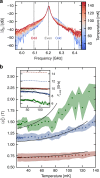Observation of quantum many-body effects due to zero point fluctuations in superconducting circuits
- PMID: 31748501
- PMCID: PMC6868017
- DOI: 10.1038/s41467-019-13199-x
Observation of quantum many-body effects due to zero point fluctuations in superconducting circuits
Abstract
Electromagnetic fields possess zero point fluctuations which lead to observable effects such as the Lamb shift and the Casimir effect. In the traditional quantum optics domain, these corrections remain perturbative due to the smallness of the fine structure constant. To provide a direct observation of non-perturbative effects driven by zero point fluctuations in an open quantum system we wire a highly non-linear Josephson junction to a high impedance transmission line, allowing large phase fluctuations across the junction. Consequently, the resonance of the former acquires a relative frequency shift that is orders of magnitude larger than for natural atoms. Detailed modeling confirms that this renormalization is non-linear and quantum. Remarkably, the junction transfers its non-linearity to about thirty environmental modes, a striking back-action effect that transcends the standard Caldeira-Leggett paradigm. This work opens many exciting prospects for longstanding quests such as the tailoring of many-body Hamiltonians in the strongly non-linear regime, the observation of Bloch oscillations, or the development of high-impedance qubits.
Conflict of interest statement
The authors declare no competing interests.
Figures




References
-
- Greentree AD, Tahan C, Cole JH, Hollenberg LCL. Quantum phase transitions of light. Nat. Phys. 2006;2:856–861. doi: 10.1038/nphys466. - DOI
-
- Carusotto I, Ciuti C. Quantum fluids of light. Rev. Mod. Phys. 2013;85:299–366. doi: 10.1103/RevModPhys.85.299. - DOI
-
- Hur KL, et al. Many-body quantum electrodynamics networks: non-equilibrium condensed matter physics with light. Comptes Rendus Phys. 2016;17:808–835. doi: 10.1016/j.crhy.2016.05.003. - DOI
-
- Houck AA, Türeci HE, Koch J. On-chip quantum simulation with superconducting circuits. Nat. Phys. 2012;8:292–299. doi: 10.1038/nphys2251. - DOI
-
- Koch J, et al. Charge-insensitive qubit design derived from the Cooper pair box. Phys. Rev. A. 2007;76:042319. doi: 10.1103/PhysRevA.76.042319. - DOI
Publication types
LinkOut - more resources
Full Text Sources

